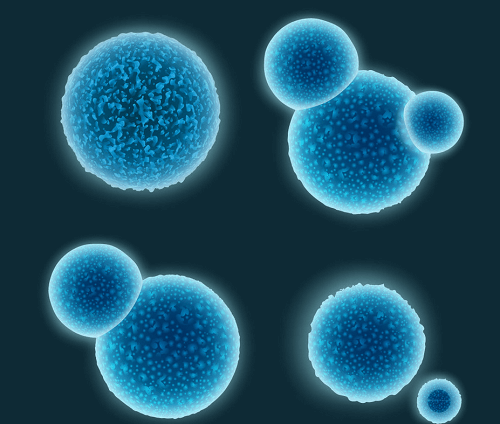Cocci bacteriaThe word Kokko, which means berry or seed, is where the word cocci come from. Archaeons or bacteria typically round, oval, or spherical are cocci. The term "cocus" relates to the form of the bacterium and can include several genera, including streptococci and staphylococci. Cocci can be easily grow in form of chains, pairs, or clusters, their growth depends on their direction and attachment during cell division. Most cocci bacteria lack flagella and are non-motile, in contrast to numerous bacilli-shaped bacteria. 
The term "cocci" is an English borrowing from a contemporary or neo-Latin noun, which itself is derived from the Greek male noun "o" (cóccos), which means "berry." Different Cocci BacteriaChains, clusters, or pairs of cocci can grow. They can be further split into based on the configuration of cocci cells:
Most streptococci and diplococci are caused by the failure of daughter cells to separate following cell division. As cell division alternates among three perpendicular planes, sarcinae are organized into cubical pockets. Gram-positive Cocci BacteriaA group of loosely grouped bacteria with a similar appearance makes up the gram-positive cocci. They are spherical or almost so, but their sizes differ greatly. Certain genera can be distinguished depending on how the cells are connected to one another, such as in pockets, chains, or clusters like grapes. Sarcina cells, for instance, are set up in cubical pockets due to the regular alternation of cell division among the three perpendicular planes. Because division always takes place in the same plane, Streptococcus species resemble a string of beads. S. pneumoniae, for instance, only has strings that are two cells long. Their name is diplococci. The division plane of Staphylococcus species is not predictable. They assemble into grape-like shapes. The diverse gram-positive cocci vary in habitat and physiology. Human skin is home to obligatory aerobes called Micrococcus spp. Although they are facultative anaerobes, Staphylococcus species also live on human skin. Lactic acid is the byproduct of the glucose they ferment. These species produce a lot of carotenoids, which give their colonies their yellow or orange color. A significant human pathogen is Staphylococcus aureus. It commonly affects the skin but can infect virtually any body part. Nosocomial (hospital-acquired) infections are frequently caused by it. Gram-positive cocci most frequently cause infections in the mouth, nasopharynx, vagina, and gut. They exhibit Gram staining positivity much like any other gram-positive bacteria (retain violet stain). Their bacterial cell wall contains extensive peptidoglycan layers. Staphylococci- These are gram-positive cocci which are organized in clusters that resemble grapes shapes. They are around 1 m in diameter, non-sporing, and non-motile. Micrococci- These gram-positive cocci appear in the shape of sporadic clusters and are also cocci. They are tetrads, and they attack carbohydrates oxidatively in contrast to staphylococci. Important human pathogens that produce pyogenic infections are among them. Adding glucose, serum, or blood to the cell media improves their ability to grow. Examples of Gram-positive cocci are shown below:
Additionally, some cocci have a thin covering of peptidoglycan (gram-negative cocci). When stained with gram stain, they don't hold on to the violet color; instead, they absorb counterstain like safranin and turn red. Several illustrations of gram-negative cocci are described below:
Diseases brought on by cocci bacteriaMost cocci bacteria are pathogens that cause disease. They are anaerobic, gram-positive members of the Streptococcus genus and are known as pneumococcus. Numerous pneumococcal illnesses, including meningitis, pneumonia, and sepsis, are caused by Streptococcus pneumonia (pneumococcus), which colonizes the nasal cavity and the respiratory system. Peptostreptococci - These are the smallest and most prevalent anaerobic cocci found in human illnesses such as perinatal infections, pleurisy, and brain abscesses. Example: Puerperal sepsis is caused by the bacteria Peptostreptococcus anaerobic. Staphylococcus - Staphylococcus aureus is an often disease-causing commensal bacteria. Most of the time, they result in skin infections such as staphylococcal scalded skin syndrome. Furthermore, staphylococcal food poisoning is caused by this species.
Next TopicHow to Increase Blood Oxygen Level
|
 For Videos Join Our Youtube Channel: Join Now
For Videos Join Our Youtube Channel: Join Now
Feedback
- Send your Feedback to [email protected]
Help Others, Please Share









